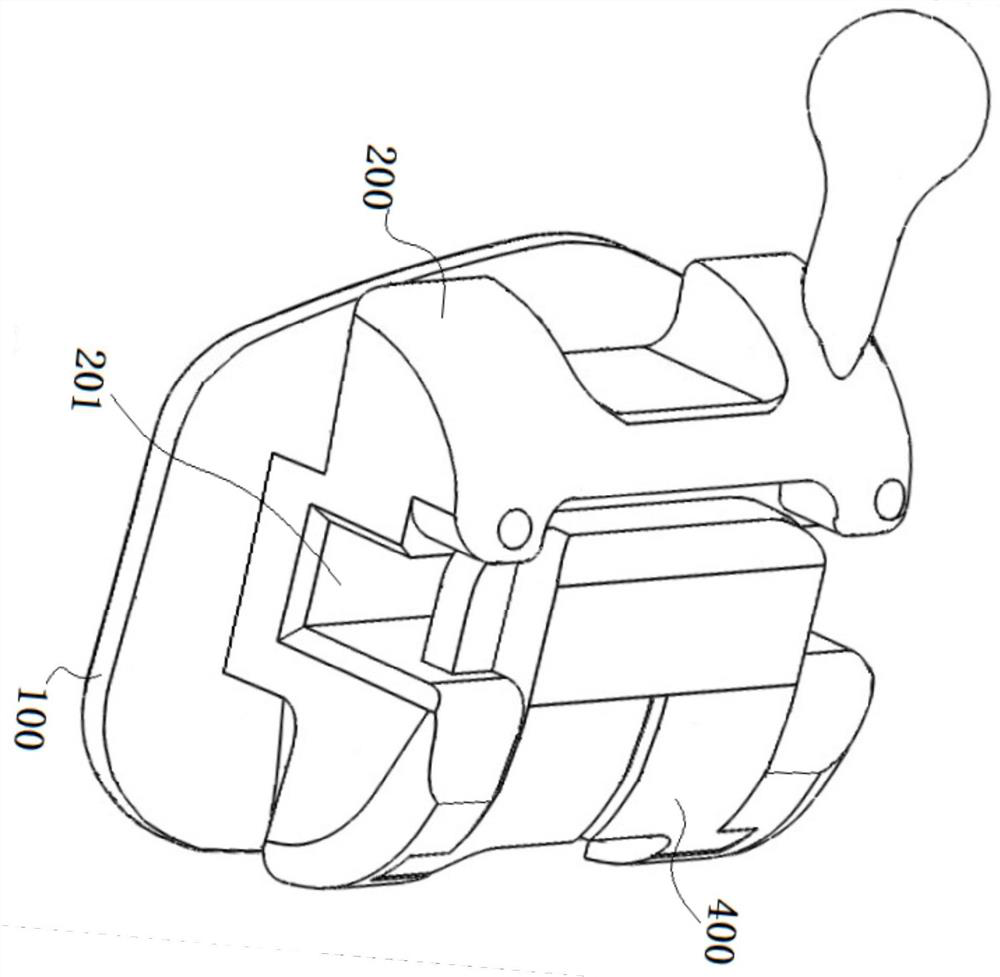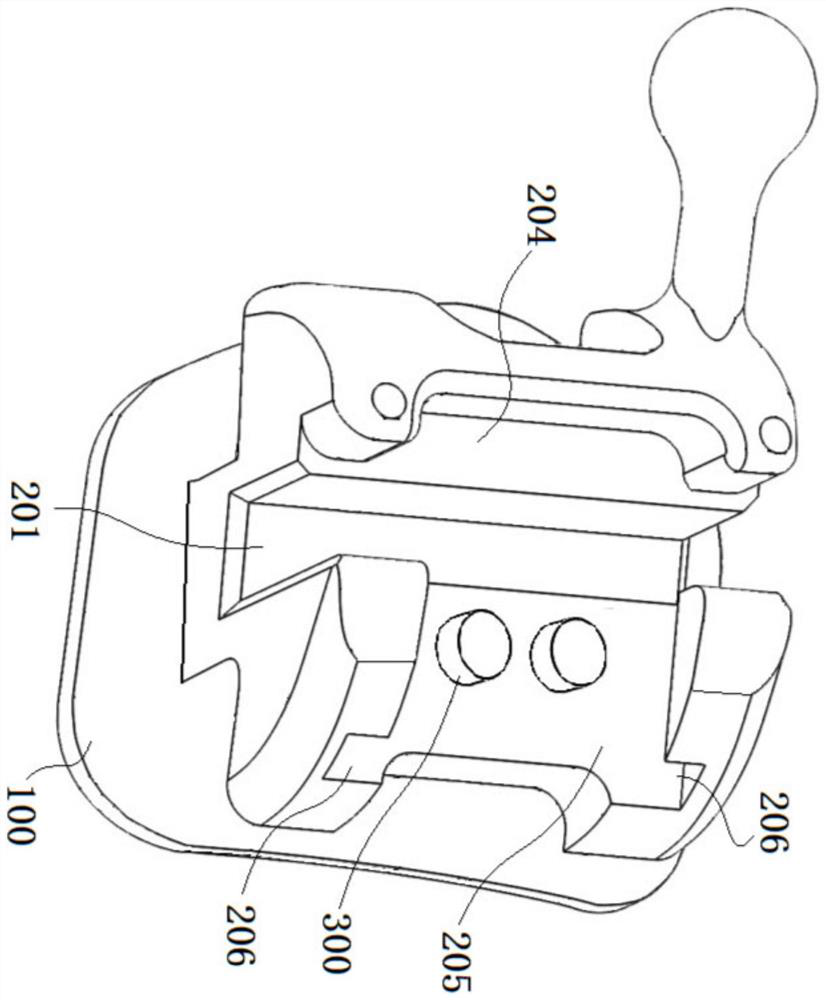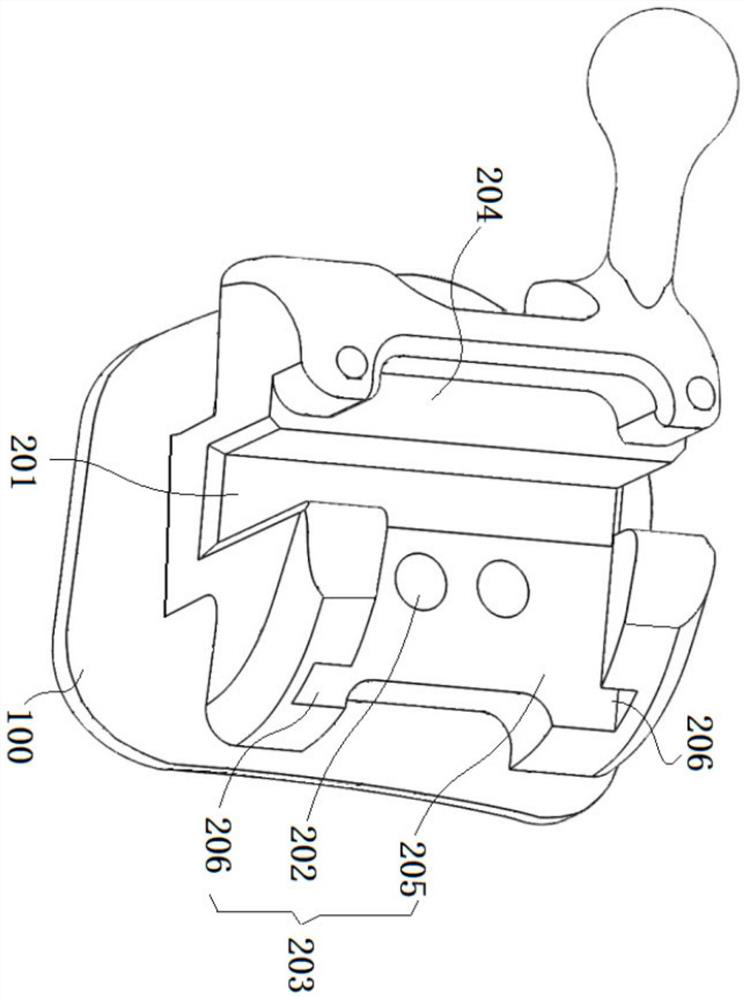Self-locking orthodontic bracket and preparation method thereof
A bracket and orthodontic technology, which is applied in the field of self-locking orthodontic brackets and its preparation, can solve the problems of opening the orthodontic wire with the locking piece, accidentally swallowing the locking piece, and human injury, so as to avoid human injury, The effect of improving safety and convenience of operation
- Summary
- Abstract
- Description
- Claims
- Application Information
AI Technical Summary
Problems solved by technology
Method used
Image
Examples
Embodiment 1
[0048] according to figure 1 As shown, a self-ligating orthodontic bracket is provided, including:
[0049] The bottom plate 100 is used to adapt to the curvature of the surface of the crown and be bonded to the surface;
[0050] The main body 200 is provided with a groove 201 for accommodating the orthodontic wire and conducting the orthodontic wire to apply a correction force to the surface of the crown, and a clamping hole 202 for inserting the clip 300; the bottom plate 100 is away from the crown One side is welded to the bottom end surface of the main body 200;
[0051] A locking piece 400, which is slidably engaged with the upper end surface of the main body 200, so as to be slidably connected with the locking member 300 thereon;
[0052] Wherein, the opening direction of the groove 201 is upward.
[0053]During specific use, the side of the locking piece 400 facing away from the main body 200 is composed of an arc surface 401 and a plane 402 integrally formed with th...
Embodiment 2
[0060] A self-locking orthodontic bracket according to Embodiment 1, according to Figure 4 As shown, the side of the locking piece 400 facing the main body 200 is provided with a downwardly opening groove 403 for sliding connection with the clip 300 , and the left and right sides of the groove 403 are arranged symmetrically. There is a fixing part 404, so that the clamping part 300 is in sliding contact with the side wall of the fixing part 404;
[0061] Wherein, the fixing part 404 is composed of a limiting part 406 with an arc-shaped concave surface 405, and a sliding part 407 formed integrally with it, and the width between the opposite sides of the two sliding parts 407 is a gradual change from narrow to wide. configuration, and the narrow end is connected to the limiting part 406, so that when the clip 300 abuts against the arc-shaped concave surface 405, the locking piece 400 is engaged with the main body 200, and when an external force acts on When the locking piece 4...
Embodiment 3
[0065] According to a kind of self-locking orthodontic bracket described in embodiment three, according to Figure 5 As shown, the left and right sides of the locking piece 400 are symmetrically provided with sliders 408 for slidingly connecting with the main body 200 .
[0066] More specifically, according to figure 2 , image 3 As shown, the end of the main body 200 facing the locking piece 400 is provided with a sliding platform 203 that is slidably adapted to the locking piece 400. groove 201 and sliding groove 205, the bottom end surface of the cover opening groove 204 is flush with the bottom end surface of the sliding groove 205 and connected through the groove 201, the bottom end surface of the groove groove 201 is located at the bottom end surface of the opening cover The groove 204 is below the bottom end surface of the sliding groove 205, so that after the orthodontic wire is placed in the groove 201, it is locked and fixed with the main body 200 through the lock...
PUM
 Login to View More
Login to View More Abstract
Description
Claims
Application Information
 Login to View More
Login to View More - R&D
- Intellectual Property
- Life Sciences
- Materials
- Tech Scout
- Unparalleled Data Quality
- Higher Quality Content
- 60% Fewer Hallucinations
Browse by: Latest US Patents, China's latest patents, Technical Efficacy Thesaurus, Application Domain, Technology Topic, Popular Technical Reports.
© 2025 PatSnap. All rights reserved.Legal|Privacy policy|Modern Slavery Act Transparency Statement|Sitemap|About US| Contact US: help@patsnap.com



